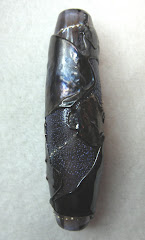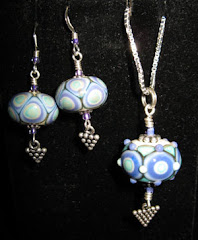 To make lampwork beads that will last,
they must be annealed in a kiln. Most bead kilns have a bead door
that you can open and insert your beads still on their mandrels,
which is ideal. Think about what you are going to use your kiln for
most of the time and buy the kiln based on that need. I am a fan of
buying a kiln for beads and a different one for fusing or PMC.
Sometimes trying to get one that will do all these things results in
none of them being done well.
To make lampwork beads that will last,
they must be annealed in a kiln. Most bead kilns have a bead door
that you can open and insert your beads still on their mandrels,
which is ideal. Think about what you are going to use your kiln for
most of the time and buy the kiln based on that need. I am a fan of
buying a kiln for beads and a different one for fusing or PMC.
Sometimes trying to get one that will do all these things results in
none of them being done well.
Think about whether you want (or need)
a digital controller. They raise the cost considerably, but are very
helpful in following your annealing schedule. For beads, the firing
schedule is relatively simple, but for complicated schedules for
fusing or casting glass, a digital controller makes it much easier.
If you happen to come across a really good deal on a bead kiln that
doesn't have a digital controller, you can buy one and install it
yourself, which is usually pretty simple. An important consideration is the
electric requirement. Most bead kilns can be simply plugged into a
household outlet, but larger kilns may need a dedicated 200 amp
outlet, so be sure to check the requirement of any kiln you are
considering. Generally, the bigger the kiln, the more amps it
requires to operate.
Another consideration is the type of
insulation in the kiln. Ones built with firebrick (these look sort
of like white bricks) will take longer to heat up to your working
temperature, and then will take longer to cool down to room
temperature- not necessarily a bad thing. A kiln lined with fiber
blanket heats up and cools off much faster. It cools off fast enough
that usually you must fire down (control the heat when coming down to
room temps) or your beads can crack. Many firebrick kilns cool off
slow enough that they can simply be turned off after an initial soak.
A firebrick kiln is more fragile and not very portable. Usually you
set them up and leave them there. Most of the toolbox type kilns use
fiber blanket, making them much lighter and easy to carry around.
These are ideal for beads, since you can easily put your beads in the
kiln with the mandrels sticking out, but they don't work too well for
fusing or PMC. After a lot of use, the fiber blanket will get mashed
down and may need replaced at some point. I have one I have used for
over 10 years, and while the blanket is much thinner than it was
originally, it still does its job just fine.
My first kiln was a large one I used
for fusing glass. It is a top loading kiln with elements in the sides and top and has a 36” diameter.
I tried using this to anneal my beads, but it didn't work because
the kiln lost too much heat every time I opened the door to put a
bead in. I could have used it for batch annealing- making a bead,
putting it in vermiculite or fiber blanket to slow down its cooling,
and then putting the room temperature beads in the kiln and running a
schedule. But there was a risk of beads cracking, so I bought my
first toolbox kiln from Don McKinny, pictured at the top. Unfortunately he no longer
makes them- it is my favorite kiln, hands down! It is for annealing
beads only, but I can get piles of beads in it.
 Then I decided I
wanted to try some casting, and I found a great deal on a firebrick
kiln that was for beads also. I thought that was a good idea- I would
have a back-up kiln for beads in case my toolbox kiln went down.
There was no digital controller on that kiln so I bought that
separately. I simply stuck the probe in the peephole in the kiln,
and programmed some schedules into the box. However I was having
some beads crack, and it finally occurred to me that the probe
reading the temps was 6-8 inches above the floor of the kiln. Since
heat rises, I thought maybe the floor of the kiln was too cool, and
sure enough, the floor of the kiln was 100 degrees cooler! So I
added 100 to the numbers in the firing schedule, and then it worked
fine.
Then I decided I
wanted to try some casting, and I found a great deal on a firebrick
kiln that was for beads also. I thought that was a good idea- I would
have a back-up kiln for beads in case my toolbox kiln went down.
There was no digital controller on that kiln so I bought that
separately. I simply stuck the probe in the peephole in the kiln,
and programmed some schedules into the box. However I was having
some beads crack, and it finally occurred to me that the probe
reading the temps was 6-8 inches above the floor of the kiln. Since
heat rises, I thought maybe the floor of the kiln was too cool, and
sure enough, the floor of the kiln was 100 degrees cooler! So I
added 100 to the numbers in the firing schedule, and then it worked
fine.
The most common problem with kilns is
the elements burning out, and if you are at all handy, they are not
difficult to replace yourself. Don't fire your kiln over the
temperature it is rated for, because that greatly shortens the life
of the elements. With a little care, your kiln will work for many
years!










